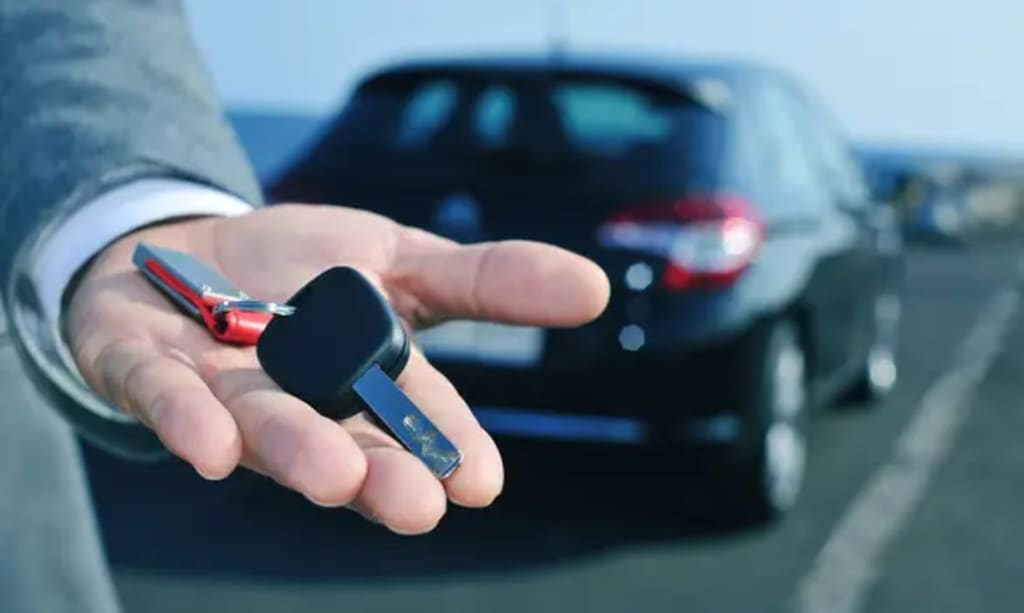
Selling a car can be a straightforward process if you follow a few basic steps. Here are some general steps to help you sell your car:
Determine the value of your car: The first step in selling your car is to determine its value. You can use websites like Kelley Blue Book or Edmunds to get an estimate of your car's value based on its make, model, year, and condition.
Prepare your car for sale: Before you put your car up for sale, you'll want to make sure it's clean and presentable. This may involve washing the exterior, vacuuming the interior, and making any necessary repairs.
Advertise your car: You can advertise your car on websites like Craigslist, Auto trader, or Cars.com, or you can place an ad in your local newspaper. Make sure to include clear pictures of your car, a detailed description, and your contact information.
Show your car: Once you have interested buyers, you'll need to schedule a time for them to come see your car. Make sure to be available and ready to answer any questions they may have.
Negotiate the price: When a potential buyer is interested in your car, they may want to negotiate the price. Be prepared to negotiate and know your lowest acceptable price.
Complete the paperwork: Once you have agreed on a price, you'll need to complete the paperwork. This may include a bill of sale, the title transfer, and any other necessary forms. Make sure to check with your state's DMV to ensure you have all the required paperwork.
Receive payment: After the paperwork is complete, you'll need to receive payment. You can accept cash, a cashier's check, or a wire transfer. Make sure to sign over the title only once you have received payment.
By following these steps, you can successfully sell your car. Just remember to be patient and open to negotiation.
Determine the value of your car
Determining the value of your car is an important step in the selling process. Here are some ways to determine the value of your car:
Use online valuation tools: You can use online valuation tools such as Kelley Blue Book, Edmunds, or NADA Guides to get an estimate of your car's value. These tools consider factors such as the make, model, year, mileage, condition, and location of the car.
Check local classifieds: Check local classifieds such as Craigslist, Auto trader, or Cars.com to see what similar cars are selling for in your area. This can give you an idea of what price to ask for your car.
Get a professional appraisal: If you want a more accurate valuation, you can get a professional appraisal from a certified mechanic or car dealer. This may cost a fee, but it can provide you with an accurate assessment of your car's value.
Consider the condition of your car: The condition of your car can have a significant impact on its value. Be honest about the condition of your car and consider factors such as any damages, wear and tear, or repairs that may need to be made.
By using these methods, you can determine the value of your car and set an appropriate asking price.
Prepare your car for sale
Preparing your car for sale is important to make a good impression on potential buyers and increase the likelihood of a successful sale. Here are some tips to prepare your car for sale:
Clean the car thoroughly: Give your car a thorough cleaning both inside and out. Wash and wax the exterior, clean the wheels, and clean the windows. Vacuum the interior, clean the seats, carpets, and dashboard, and remove any clutter or personal items.
Address any repairs: Fix any minor issues with your car, such as dents, scratches, or broken parts. This can help make your car more attractive to potential buyers and increase its value.
Check the oil and fluids: Make sure to check the oil level, brake fluid, power steering fluid, and coolant levels. Top up any fluids that are low.
Check the tires: Make sure the tires are properly inflated and have enough tread depth. Replace any worn or damaged tires.
Gather maintenance records: Gather any maintenance records you have for the car, including oil changes, repairs, and inspections. This can help reassure buyers that the car has been well-maintained.
Consider a professional detailing: If your car needs more than just a basic cleaning, consider getting a professional detailing. This can help remove any stubborn stains or odors and make your car look like new.
By following these steps, you can prepare your car for sale and make it more attractive to potential buyers.
Advertise your car
Advertising your car is an important step in the selling process to attract potential buyers. Here are some tips to effectively advertise your car:
Take clear and detailed pictures: Take clear and detailed pictures of your car that highlight its best features. Make sure to take pictures of the exterior, interior, and any special features or options.
Write a detailed description: Write a detailed description of your car that includes the make, model, year, mileage, and any special features or options. Be honest and accurate in your description, and mention any repairs or maintenance that has been done recently.
Set a realistic price: Set a realistic price based on the car's condition, mileage, and market value. You can use online valuation tools or check local classifieds to get an idea of what similar cars are selling for in your area.
Advertise in multiple places: Advertise your car in multiple places, such as online classifieds like Craigslist, Auto trader, or Cars.com, as well as local newspapers or car dealerships. This can help increase your exposure to potential buyers.
Respond promptly to inquiries: When potential buyers contact you, respond promptly and answer any questions they may have. Be friendly and professional, and provide any additional information or pictures as requested.
Be prepared for test drives: When potential buyers come to see your car, be prepared to offer a test drive. Make sure to ride along and answer any questions they may have.
By following these tips, you can effectively advertise your car and increase your chances of a successful sale.
Show your car
When it comes to showing your car to potential buyers, it's important to make a good impression and provide a positive experience. Here are some tips to effectively show your car:
Schedule appointments: Schedule appointments with potential buyers at a convenient time for both parties. Make sure to confirm the appointment a day or two beforehand.
Choose a well-lit location: Choose a well-lit location for the meeting, such as a well-lit parking lot. This can help potential buyers see the car more clearly and make a better impression.
Be ready with the keys and documents: Have the car keys and documents, such as the registration, title, and maintenance records, ready to go.
Be prepared to answer questions: When potential buyers arrive, be prepared to answer any questions they may have about the car's history, condition, or features. Be honest and accurate in your responses.
Provide a test drive: Offer a test drive to potential buyers if they are interested. Make sure to ride along and answer any questions they may have during the test drive.
Don't pressure the buyer: Avoid pressuring the buyer to make a decision. Give them space and time to consider the car on their own terms.
By following these tips, you can effectively show your car to potential buyers and provide a positive experience that can increase your chances of a successful sale.
Negotiate the price
Negotiating the price with potential buyers is a common part of the selling process. Here are some tips to effectively negotiate the price:
Be prepared to discuss the price: Be prepared to discuss the price with potential buyers and be open to their offers. Have a minimum price in mind that you are willing to accept.
Start with a higher asking price: Start with a slightly higher asking price than what you actually want to get for the car. This can give you room to negotiate with potential buyers.
Consider the buyer's perspective: Consider the buyer's perspective and be willing to compromise on the price. If the buyer raises legitimate concerns about the car's condition or value, consider lowering the price accordingly.
Stay calm and professional: Stay calm and professional during the negotiation process. Avoid getting defensive or emotional, and remain focused on the facts.
Don't be afraid to walk away: If the buyer is not willing to meet your minimum price or if the negotiation is not going well, don't be afraid to walk away from the sale.
Get everything in writing: Once the negotiation is complete and a price has been agreed upon, make sure to get everything in writing. Write up a bill of sale that includes the agreed-upon price, the buyer's name and address, and any other relevant details.
By following these tips, you can effectively negotiate the price with potential buyers and ensure a successful sale.
Complete the paperwork
Completing the paperwork is an important step in the selling process to legally transfer ownership of the car to the buyer. Here are the steps to complete the paperwork:
Sign over the title: Sign over the title of the car to the buyer. Make sure to fill out all of the required fields on the title, including the date of sale, the sale price, and the odometer reading.
Provide a bill of sale: Provide the buyer with a bill of sale that includes the agreed-upon price, the buyer's name and address, and any other relevant details. Make sure to keep a copy for your records.
Transfer the registration: If required by your state, transfer the registration of the car to the buyer. This may involve filling out additional paperwork and paying transfer fees.
Cancel insurance: Cancel your insurance on the car once the sale is complete.
Notify the DMV: Notify the Department of Motor Vehicles (DMV) in your state that the car has been sold. This can help protect you from liability if the buyer fails to register the car or gets into an accident before transferring the registration.
By following these steps, you can effectively complete the paperwork and legally transfer ownership of the car to the buyer.
Receive payment
Receiving payment is the final step in the car selling process. Here are some tips to ensure a smooth payment transaction:
Decide on the payment method: Decide on the payment method with the buyer before completing the sale. Common payment methods include cash, certified check, or wire transfer. Consider the pros and cons of each payment method before making a decision.
Verify payment: Verify that the payment has been made before transferring ownership of the car to the buyer. For cash payments, count the money carefully and consider using a counterfeit detection pen. For certified checks or wire transfers, wait for the payment to clear before completing the sale.
Provide a receipt: Provide a receipt to the buyer once payment has been received. The receipt should include the date of sale, the agreed-upon price, and any other relevant details.
Transfer ownership: Once payment has been received and verified, transfer ownership of the car to the buyer by signing over the title and providing any other necessary paperwork.
Keep records: Keep records of the sale and payment transaction for your records.
By following these tips, you can ensure a smooth payment transaction and complete the sale of your car.
About the Creator
santhanu
Hi am santhanu i just share about my experience
Enjoyed the story? Support the Creator.
Subscribe for free to receive all their stories in your feed. You could also pledge your support or give them a one-off tip, letting them know you appreciate their work.






Comments (1)
check my stories its useful to sales people